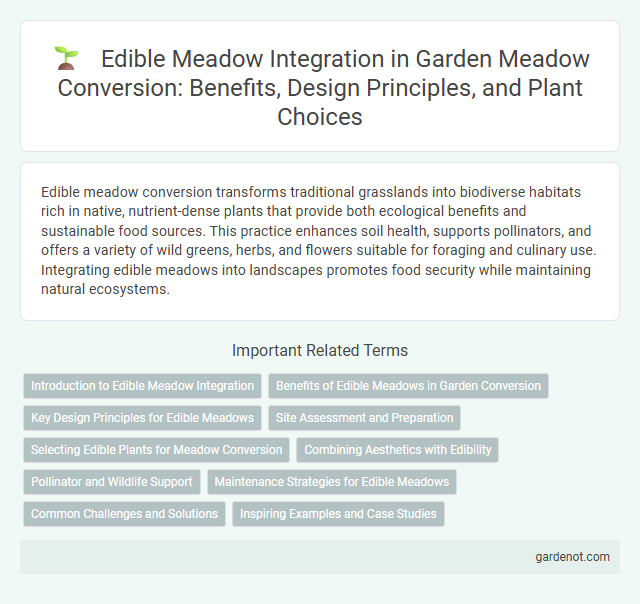Edible meadow conversion transforms traditional grasslands into biodiverse habitats rich in native, nutrient-dense plants that provide both ecological benefits and sustainable food sources. This practice enhances soil health, supports pollinators, and offers a variety of wild greens, herbs, and flowers suitable for foraging and culinary use. Integrating edible meadows into landscapes promotes food security while maintaining natural ecosystems.
Introduction to Edible Meadow Integration
Edible meadow integration enhances biodiversity by combining native wildflowers and herbs with nutrient-rich edible plants such as chives, kale, and nasturtium. These meadows support pollinators, improve soil health, and provide sustainable foraging opportunities within urban and rural landscapes. Implementing edible meadows contributes to ecological balance while offering seasonal fresh produce directly from the environment.
Benefits of Edible Meadows in Garden Conversion
Edible meadows enhance garden conversion by providing a sustainable source of fresh fruits, vegetables, and herbs, promoting biodiversity and supporting pollinators like bees and butterflies. Incorporating native edible plants into a meadow increases soil fertility through natural nitrogen fixing and reduces maintenance needs by minimizing irrigation and chemical inputs. This approach fosters resilient ecosystems, improves food security, and creates aesthetically pleasing landscapes that encourage outdoor activity and environmental education.
Key Design Principles for Edible Meadows
Key design principles for edible meadows prioritize biodiversity by integrating native, nutrient-rich plants that support pollinators and local wildlife. Soil health optimization through organic amendments and minimal disturbance ensures sustainable growth and nutrient cycling. Strategic planting patterns enhance productivity and aesthetic appeal while promoting ecosystem resilience and long-term food security.
Site Assessment and Preparation
Site assessment for edible meadow conversion involves evaluating soil quality, sunlight exposure, and existing vegetation to ensure optimal growing conditions. Preparation includes soil testing, removing invasive species, and amending the soil with organic matter to support nutrient-rich plant growth. Proper site preparation promotes biodiversity and enhances the sustainability of the edible meadow ecosystem.
Selecting Edible Plants for Meadow Conversion
Selecting edible plants for meadow conversion involves prioritizing native, nutrient-rich species such as wild strawberries, clover, and dandelion to promote biodiversity and soil health. Incorporating a variety of perennials like sorrel and lamb's quarters ensures year-round edible yields and supports pollinator populations. Careful consideration of plant compatibility and sun exposure enhances the productivity and sustainability of the edible meadow ecosystem.
Combining Aesthetics with Edibility
Edible meadows blend vibrant wildflowers and nutrient-rich plants, creating visually stunning landscapes that provide seasonal harvests of herbs, greens, and edible flowers. This sustainable gardening approach maximizes biodiversity while offering a continuous supply of fresh, organic ingredients for culinary use. Integrating pollinator-friendly species enhances ecosystem health and ensures long-term productivity in edible meadow conversions.
Pollinator and Wildlife Support
Edible meadows provide vital habitats that boost pollinator populations such as bees, butterflies, and native insects by offering diverse nectar and pollen sources throughout the growing season. These meadows enhance wildlife support by sustaining various bird species and small mammals that rely on the rich plant diversity for food and shelter. Optimizing plant selection with native flowering species ensures maximum ecological benefits, promoting biodiversity and ecosystem resilience.
Maintenance Strategies for Edible Meadows
Effective maintenance strategies for edible meadows emphasize regular pruning and selective weeding to promote healthy growth and maximize edible yield. Soil health monitoring, including nutrient testing and organic amendments, ensures optimal fertility and supports diverse plant species in the meadow. Seasonal mowing and controlled grazing prevent overgrowth and encourage regeneration of fruit-bearing and herbaceous plants essential for edible forage.
Common Challenges and Solutions
Edible meadow conversion faces common challenges such as soil nutrient imbalance, weed invasion, and ensuring diverse plant establishment. Implementing soil testing and tailored fertilization improves nutrient levels, while mulching and selective herbicides control weeds effectively. Planning for seasonal planting cycles and using native edible species supports sustainable diversity and resilience in the meadow ecosystem.
Inspiring Examples and Case Studies
Edible meadows showcase diverse plant species that combine biodiversity with sustainable food production, exemplified by projects in urban parks and community gardens where native herbs, berries, and edible flowers thrive. Case studies from European cities reveal enhanced pollinator activity and improved soil health alongside increased local food security and community engagement. These inspiring examples demonstrate how integrating edible plants into meadow conversion fosters ecological resilience and provides nutritious, foraged food sources.
Edible meadow Infographic

 gardenot.com
gardenot.com